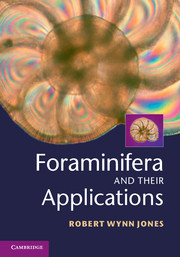Book contents
- Frontmatter
- Dedication
- Contents
- Preface
- Acknowledgements
- 1 Past, present and future foraminiferal research
- 2 Research methods
- 3 Biology, morphology and classification
- 4 Ecology
- 5 Palaeobiology, palaeoecology (or palaeoenvironmental interpretation)
- 6 Palaeobiological or evolutionary history of the Foraminifera
- 7 Biostratigraphy
- 8 Sequence stratigraphy
- 9 Applications and case studies in petroleum geology
- 10 Applications and case studies in mineral geology
- 11 Applications and case studies in engineering geology
- 12 Applications and case studies in environmental science
- 13 Applications and case studies in archaeology
- References
- Index
13 - Applications and case studies in archaeology
Published online by Cambridge University Press: 05 December 2013
- Frontmatter
- Dedication
- Contents
- Preface
- Acknowledgements
- 1 Past, present and future foraminiferal research
- 2 Research methods
- 3 Biology, morphology and classification
- 4 Ecology
- 5 Palaeobiology, palaeoecology (or palaeoenvironmental interpretation)
- 6 Palaeobiological or evolutionary history of the Foraminifera
- 7 Biostratigraphy
- 8 Sequence stratigraphy
- 9 Applications and case studies in petroleum geology
- 10 Applications and case studies in mineral geology
- 11 Applications and case studies in engineering geology
- 12 Applications and case studies in environmental science
- 13 Applications and case studies in archaeology
- References
- Index
Summary
This chapter deals with applications and case studies in archaeology. It contains sections on applications – in archaeostratigraphy and in environmental archaeology – and on case studies of applications. The section on case studies includes ones on the palaeoenvironmental interpretation of the Pleistocene–Holocene of the British Isles, using proxy Recent benthic foraminiferal distribution data; on the Early Palaeolithic of Boxgrove and Valdoe, West Sussex (500 000 years BP); and on the Medieval of the City of London (AD 1200?–1350).
Applications
In archaeology, Foraminifera and other micro- and macro-fossils have been used to provide information on the stratigraphic and, in particular, palaeoenvironmental – including palaeoclimatic – context of human evolution, dispersal and activity (including settlement and land use) (see Whittaker et al., 2003; Jones, 2006; Jones & Whittaker, in Whittaker & Hart, 2010; Jones, 2011a; and additional references cited therein; see also the further reading list at the end of the chapter, and Sections 13.1.1 and 13.1.2).
Information
- Type
- Chapter
- Information
- Foraminifera and their Applications , pp. 277 - 293Publisher: Cambridge University PressPrint publication year: 2013
